语用学 (1)
- 格式:pptx
- 大小:704.61 KB
- 文档页数:1
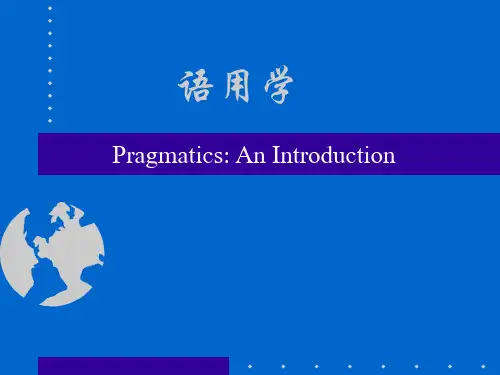

Chapter 5 SemanticsⅠ. Decide whether each of the following statements is True or False:1. Dialectal(方言的)synonyms(同义关系)can often be found in different regional dialects such as British English and American English but cannot be found within the variety itself, for example, within British English or American English. F2. Sense is concerned with the relationship between the linguistic element and the non-linguistic world of experience, while the reference deals with the inherent meaning of the linguistic form. F3. Linguistic forms having the same sense may have different references in different situations. T4. In semantics, meaning of language is considered as the intrinsic and inherent relation to the physical world of experience. F5. Contextualism is based on the presumption that one can derive meaning from or reduce meaning to observable contexts. T6. Behaviourists attempted to define the meaning of a language form as the situation in which the speaker utters it and the response it calls forth in the hearer. T7. The meaning of a sentence is the sum total of the meanings of all its components. F8. Most languages have sets of lexical items similar in meaning but ranked differently according to their degree of formality. T9. “It is hot.” is a no-place predication because it contains no argument. T10. In grammatical analysis, the sentence is taken to be the basic unit, but in semantic analysis of a sentence, the basic unit is predication, which is the abstraction of the meaning of a sentence. T Ⅱ. Fill in each of the following blanks with one word which begins with the letter given:11. Semantics can be defined as the study of meaning.12. The conceptualist view holds that there is no direct link between a linguistic form and what it refers to.13. Reference means what a linguistic form refers to in the real, physical world; it deals with the relationship between the linguistic element and the non-linguistic world of experience.14. Words that are close in meaning are called synonyms.15. When two words are identical in sound, but different in spelling and meaning, they are called homophones(同音/形异义词).16. Relational opposites are pairs of words that exhibit the reversal of a relationship between the two items.17. Componential(指数)analysis is based upon the belief that the meaning of a word can be divided into meaning components.18. Whether a sentence is semantically meaningful is governed by rules called selectional restrictions, which are constraints on what lexical items can go with what others.19. An argument is a logical participant in a predication, largely identical with the nominal element(s) in a sentence.20. According to the naming theory of meaning, the words in a lan-guage are taken to be labels of the objects they stand for.Ⅲ. There are four choices following each statement. Mark the choice that can best completethe statement:21. The naming theory is advanced by ___A_____.A.PlatoB.BloomfieldC. Geoffrey LeechD. Firth22. “We shall know a word by the company it keeps.” This statement represents __B_____.A. the conceptualist view(概念)B. contexutalismC. the naming theoryD. behaviourism23. Which of the following is not true? DA. Sense is concerned with the inherent meaning of the linguistic form.B. Sense is the collection of all the features of the linguistic form.C. Sense is abstract and decontextualized(去文本化).D. Sense is the aspect of meaning dictionary compilers are not interested in.24. “Can I borrow your bike?”___D____ “You have a bike.”A. is synonymous withB. is inconsistent withC. entailsD. presupposes25. _____B______ is a way in which the meaning of a word can be dissected into meaning components, called semantic features.A. Predication analysisB. Componential analysisC. Phonemic analysisD. Grammatical analysis26. “Alive”and “dead” are ______C________.A. gradable antonymsB. relational opposites(关系对立)C. complementary antonymsD. None of the above27. ____A_____ deals with the relationship between the linguistic element and the non-linguistic world of experience.A. ReferenceB. ConceptC. SemanticsD. Sense28. _____C______ refers to the phenomenon that words having different meanings have the same form.A. PolysemyB. SynonymyC. HomonymyD. Hyponymy29. Words that are close in meaning are called ______D________.A. homonymsB. polysemyC. hyponymsD. synonyms30. The grammaticality of a sentence is governed by ___A____.A. grammatical rulesB. selectional restrictionsC. semantic rulesD. semantic featuresⅣ. Define the following terms:31.Semantics32. sense33. reference34. synonymy35. polysemy36. homonymy37. homophones38. Homographs39. complete homonyms40. hyponymy41. antonymy42 componential analysis43. grammatical meaning44. predication45. Argument46. predicate47. two-place predicationⅤ. Answer the following questions:48. Why do we say that a meaning of a sentence is not the sum total of the meanings of all its components?49. What is componential analysis? Illustrate it with examples.50. How do you distinguish between entailment and presupposition in terms of truth values?51. How do you account for such sense relations between sentences as synonymous relation, inconsistent relation in terms of truth values?52. According to the way synonyms differ, how many groups can we classify synonyms into? Illustrate them with examples.53. What are the major views concerning the study of meaning? How they differ?Chapter 6 PragmaticsⅠ. Decide whether each of the following statements is True or False:1. Both semantics and pragmatics study how speakers of a language use sentences to effect successful communication2. Pragmatics treats the meaning of language as something intrinsic and inherent.3. It would be impossible to give an adequate description of meaning if the context of language4. What essentially distinguishes semantics and pragmatics is whether in the study of meaning the context of use is considered.5. The major difference between a sentence and an utterance is that a sentence is not uttered while an utterance is.6. The meaning of a sentence is abstract, but context-dependent.7. The meaning of an utterance is decontexualized, therefore stable.8. Utterances always take the form of complete sentences9. Speech act theory was originated with the British philosopher John Searle.10. Speech act theory started in the late 50’s of the 20th century.11. Austin made the distinction between a constative and a performative.12. Perlocutionary act is the act of expressing the speaker’s intention.Ⅱ. Fill in each blank below with one word which begins with the letter given:13. P_________ is the study of how speakers of a language use sentences to effect successful communication.14. What essentially distinguishes s_______ and pragmatics is whether in the study of meaning the context of use is considered.15. The notion of c_________ is essential to the pragmatic study of language.16. If we think of a sentence as what people actually utter in the course of communication, it becomes an u___________.17. The meaning of a sentence is a_______, and decontexualized.18. C________ were statements that either state or describe, and were thus verifiable.19. P________ were sentences that did not state a fact or describe a state, and were not verifiable.20. A l_________ act is the act of uttering words, phrases, clauses. It is the act of conveying literal meaning by means of syntax, lexicon and phonology.21. An i__________ act is the act of expressing the speaker’s intention; it is the act performed in saying something.22. A c_________ is commit the speaker himself to some future course of action.23. An e________ is to express feelings or attitude towards an existing state.24. There are four maxims under the cooperative principle: the maxim of q_______, the maxim of quality, the maxim of relation and the maxim of manner.Ⅲ. There are four choices following each statement. Mark the choice that can best complete the statement:25. _________ does not study meaning in isolation, but in context.A. PragmaticsB. SemanticsC. Sense relationD. Concept26. The meaning of language was considered as something _______ in traditional semantics.A. contextualB. behaviouristicC. intrinsicD. logical27. What essentially distinguishes semantics and pragmatics is whether in the study of meaningA. referenceB. speech actC. practical usageD. context28. A sentence is a _________ concept, and the meaning of a sentence is often studied in isolation.A. pragmaticB. grammaticalC. mentalD. conceptual29. If we think of a sentence as what people actually utter in the course of communication, it becomes a(n) _________.A. constativeB. directiveC. utteranceD. expressive30. Which of the following is true?A. Utterances usually do not take the form of sentences.B. Some utterances cannot be restored to complete sentences.C. No utterances can take the form of sentences.D. All utterances can be restored to complete sentences.31. Speech act theory did not come into being until __________.A. in the late 50’s of the 20the centuryB. in the early 1950’sC. in the late 1960’sD. in the early 21st century32. __________ is the act performed by or resulting from saying something; it is the consequence of, or the change brought about by the utterance.A. A locutionary actB. An illocutionary actC. A perlocutionary actD. A performative act33. According to Searle, the illocutionary point of the representative is ______.A. to get the hearer to do somethingB. to commit the speaker to something’s being the caseC. to commit the speaker to some future course of actionD. to express the feelings or attitude towards an existing state of affairs34. All the acts that belong to the same category share the same purpose, but they differ __________.A. in their illocutionary acts.B. in their intentions expressedC. in their strength or forceD. in their effect brought about35. __________ is advanced by Paul GriceA. Cooperative PrincipleB. Politeness PrincipleC. The General Principle of Universal GrammarD. Adjacency Principle36. When any of the maxims under the cooperative principle is flouted, _______ might arise.A. impolitenessB. contradictionsC. mutual understandingD. conversational implicaturesⅣ. Define the terms below:37. pragmatics38. context39. utterance meaning40. sentence meaning41. constative42. performative43. locutionary act44. illocutionary act45. perlocutionary act 46. Cooperative PrincipleⅤ. Answer the following questions as comprehensively as possible. Give examples for illustration if necessary:47. How are semantics and pragmatics different from each other?48. How does a sentence differ from an utterance?49. How does a sentence meaning differ from an utterance meaning?50. Discuss in detail the locutionary act, illocutionary act and perlocutionary act.51. Searle classified illocutionary act into five categories. Discuss each of them in detail with examples.52. What are the four maxims under the cooperative principle?53. How does the flouting of the maxims give rise to conversational implicatures?。

形式语用学与显义学说——兼谈显谓与汉语配价研究的关系蒋严对隶属语用层面的现象、过程、原则和语境因素作形式化刻画,进而发展出自成体系的形式语用学(formal pragmatics)乃至计算语用学(computational pragmatics)理论框架,这方面的研究是较为新颖的课题,产自语言学界的成果在数量上远不如逻辑和人工智能领域中的类似研究成果。
大部分研究是随着认知科学的发展需要应运而生的,在很大程度上也得益自形式语言学理论和应用逻辑的迅速发展。
当前可以观察到的一些研究方向是:对推理语用学(inferential pragmatics)各派理论的形式化研究;对语境的形式化刻画;话语表达理论(DRT)的研究对象从语义现象朝语用现象的扩展和延伸;优选论(optimality theory)对语用问题的研究;以博弈论(game theory)为基础创建的形式语用理论;从关联逻辑(relevance logic,另译相干逻辑)、决策理论(decision theory)、溯因推理(abductive inference)等逻辑角度提出的理论;应智能交际人(embodied conversational agent)的仿真对话需要而做出的形式语用研究,等等○1。
尽管形式语用学迄今并无明确的范围,也没有公认的研究目标和研究程序,既有的研究成果和文献却已相当可观。
但因现有的研究是在语言学、计算科学、逻辑、人工智能几个不同学科分别开展的,有各自为阵的特殊性,跨学科的对话和兼容性都较少,这种缺憾在发表的文献中也反映了出来。
故此,在现阶段尚难以从既有成果中整合出一套兼收并蓄、为多数从事形式语用工作的学者所共同接受的形式化系统○2。
出于对本书编辑主题方面的考虑,我们无意在此对语用形式化的各种研究作全面述评○3。
我们要讨论的题目相对较狭窄具体,试图通过对源于关联理论(relevance theory)的显义(explicature)这个较为新颖的概念作一番形式上的探讨,得出更为精确的定义,揭示显义及其相关语用过程显谓(explicating)的形式特性,进而考察这些特性对语用学、语言哲学和汉语语法研究所带来的理论后果,为建立全面的形式语用学体系打下基础。
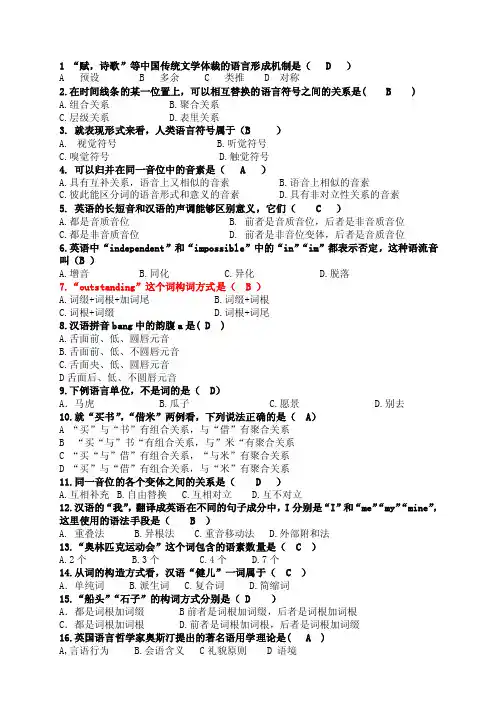
1 “赋,诗歌”等中国传统文学体裁的语言形成机制是( D )A 预设B 多余C 类推D 对称2.在时间线条的某一位置上,可以相互替换的语言符号之间的关系是( B )A.组合关系B.聚合关系C.层级关系D.表里关系3. 就表现形式来看,人类语言符号属于(B )A.视觉符号B.听觉符号C.嗅觉符号D.触觉符号4. 可以归并在同一音位中的音素是( A )A.具有互补关系,语音上又相似的音素B.语音上相似的音素C.彼此能区分词的语音形式和意义的音素D.具有非对立性关系的音素5. 英语的长短音和汉语的声调能够区别意义,它们( C )A.都是音质音位B. 前者是音质音位,后者是非音质音位C.都是非音质音位D. 前者是非音位变体,后者是音质音位6.英语中“independent”和“impossible”中的“in”“im”都表示否定,这种语流音叫(B )A.增音B.同化C.异化D.脱落7.“outstanding”这个词构词方式是( B )A.词缀+词根+加词尾B.词缀+词根C.词根+词缀D.词根+词尾8.汉语拼音bang中的韵腹a是( D )A.舌面前、低、圆唇元音B.舌面前、低、不圆唇元音C.舌面央、低、圆唇元音D舌面后、低、不圆唇元音9.下例语言单位,不是词的是( D)A.马虎 B.瓜子 C.愿景 D.别去10.就“买书”,“借米”两例看,下列说法正确的是( A)A “买”与“书”有组合关系,与“借”有聚合关系B “买“与”书“有组合关系,与”米“有聚合关系C “买“与”借”有组合关系,“与米”有聚合关系D “买”与“借”有组合关系,与“米”有聚合关系11.同一音位的各个变体之间的关系是( D )A.互相补充B.自由替换C.互相对立D.互不对立12.汉语的“我”,翻译成英语在不同的句子成分中,I分别是“I”和“me”“my”“mine”,这里使用的语法手段是( B )A.重叠法B.异根法C.重音移动法D.外部附和法13.“奥林匹克运动会”这个词包含的语素数量是( C )A.2个B.3个C.4个D.7个14.从词的构造方式看,汉语“健儿”一词属于( C )A.单纯词 B.派生词 C.复合词 D.简缩词15.“船头”“石子”的构词方式分别是( D )A.都是词根加词缀 B前者是词根加词缀,后者是词根加词根C.都是词根加词根 D.前者是词根加词根,后者是词根加词缀16.英国语言哲学家奥斯汀提出的著名语用学理论是( A )A,言语行为 B.会语含义 C礼貌原则 D 语境17.把现代汉语第三人称代词写成“他”“她”( D )A 表示性范畴B 表示格范畴C表示人称范畴D 什么语法范畴都不表示18.汉语普通话中没有的发音部位是( B )A.双唇 B 齿间 C唇齿 D 舌面19.下列关于”语言”和”言语”的说法不正确的是( C)A.语言是抽象的,言语是具体的B.语言是有限的,言语是无限的C.语言是个别的,言语是一般的D.语言是从大量的言语事实中抽象概括出来的20.下列特点中不属于屈折语的有(B )A.有丰富的词形变化B.没有内部屈折C.一个变词语素可以同时表示好几种语法意 D:词根和变词语素之间结合紧密21 下列语言。
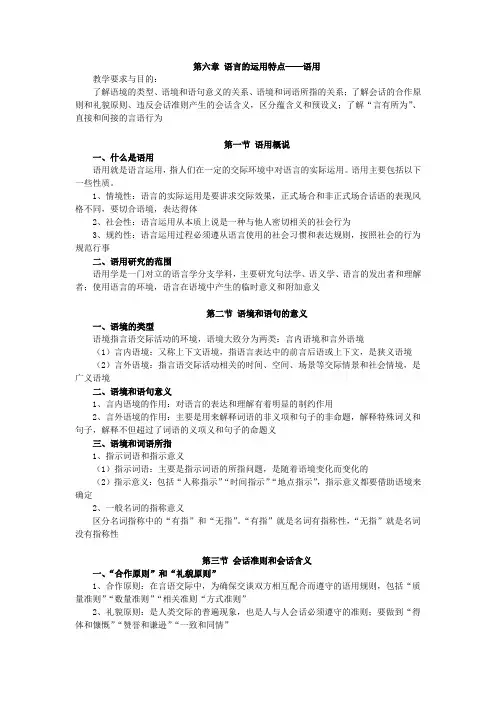
第六章语言的运用特点──语用教学要求与目的:了解语境的类型、语境和语句意义的关系、语境和词语所指的关系;了解会话的合作原则和礼貌原则、违反会话准则产生的会话含义,区分蕴含义和预设义;了解“言有所为”、直接和间接的言语行为第一节语用概说一、什么是语用语用就是语言运用,指人们在一定的交际环境中对语言的实际运用。
语用主要包括以下一些性质。
1、情境性:语言的实际运用是要讲求交际效果,正式场合和非正式场合话语的表现风格不同,要切合语境,表达得体2、社会性:语言运用从本质上说是一种与他人密切相关的社会行为3、规约性:语言运用过程必须遵从语言使用的社会习惯和表达规则,按照社会的行为规范行事二、语用研究的范围语用学是一门对立的语言学分支学科,主要研究句法学、语义学、语言的发出者和理解者;使用语言的环境,语言在语境中产生的临时意义和附加意义第二节语境和语句的意义一、语境的类型语境指言语交际活动的环境,语境大致分为两类:言内语境和言外语境(1)言内语境:又称上下文语境,指语言表达中的前言后语或上下文,是狭义语境(2)言外语境:指言语交际活动相关的时间、空间、场景等交际情景和社会情境,是广义语境二、语境和语句意义1、言内语境的作用:对语言的表达和理解有着明显的制约作用2、言外语境的作用:主要是用来解释词语的非义项和句子的非命题,解释特殊词义和句子,解释不但超过了词语的义项义和句子的命题义三、语境和词语所指1、指示词语和指示意义(1)指示词语:主要是指示词语的所指问题,是随着语境变化而变化的(2)指示意义:包括“人称指示”“时间指示”“地点指示”,指示意义都要借助语境来确定2、一般名词的指称意义区分名词指称中的“有指”和“无指”。
“有指”就是名词有指称性,“无指”就是名词没有指称性第三节会话准则和会话含义一、“合作原则”和“礼貌原则”1、合作原则:在言语交际中,为确保交谈双方相互配合而遵守的语用规则,包括“质量准则”“数量准则”“相关准则“方式准则”2、礼貌原则:是人类交际的普遍现象,也是人与人会话必须遵守的准则;要做到“得体和慷慨”“赞誉和谦逊”“一致和同情”二、违反会话准则产生的会话含义1、被迫违反或放弃会话准则:说话人在某些场合或条件下只能迁就一种会话原则放弃另一种会话原则2、故意违反会话准则产生的会话含义:说话人故意违反会话原则来表达某种特殊的意义,或者说是在语句背后还暗含其他意义甲:我这副山水图怎么样/乙:嗯:装裱的不错三、蕴含义和预设义1、蕴含义:句子的基本信息中包含的上位义或整体义,具体分为“衍推义”和“隐含义”两种2、预设义:不在句子断言的范围之内,指句子包含的某个背景信息如:他哥哥在北京上大学第四节言语行为一、言有所为用语句做事,说话本身就是在做“建议、劝告、请求、命令”这一些事,通过语言形式来完成交际的行为就是言语行为二、言内、言外、言后1、言内:言内行为是一种述事行为,指的是“说话”这一行为本身,即通过语音、语汇、语法的等语言形式和手段来传递信息2、言外:言外行为是说话人用某种语言的语音形式说出了这句话,就完成了述事这一行为3、言后:言后是指说话带来的效果三、直接与间接的言语行为1、直接言语行为:用字面意义来实现交际如:我们把空调关了好吗?2、间接言语行为:委婉暗示自己的交际信息如:今天有点冷。
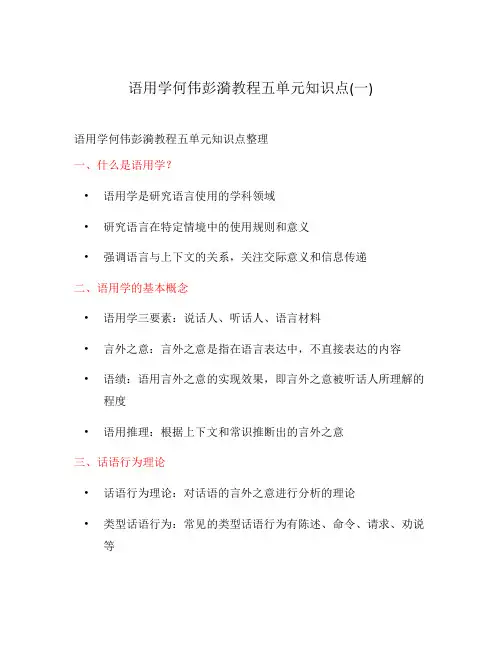
语用学何伟彭漪教程五单元知识点(一)语用学何伟彭漪教程五单元知识点整理一、什么是语用学?•语用学是研究语言使用的学科领域•研究语言在特定情境中的使用规则和意义•强调语言与上下文的关系,关注交际意义和信息传递二、语用学的基本概念•语用学三要素:说话人、听话人、语言材料•言外之意:言外之意是指在语言表达中,不直接表达的内容•语绩:语用言外之意的实现效果,即言外之意被听话人所理解的程度•语用推理:根据上下文和常识推断出的言外之意三、话语行为理论•话语行为理论:对话语的言外之意进行分析的理论•类型话语行为:常见的类型话语行为有陈述、命令、请求、劝说等•言外之意与行为意图:言外之意是指话语背后所表达的更深层的意图,与说话人的行为意图相关四、言外之意的推理•含蓄和虚化:通过不直接陈述言外之意,而采用隐喻、暗示等表达方式•猜测与推断:根据对话语上下文和背景知识的推理,获取言外之意•领域知识与语境:对言外之意推理的重要依据是对话语所在领域或语境的了解五、言外之意的跨文化差异•礼貌与文化:不同文化对待言外之意的态度和表达方式存在差异•跨文化误读和理解:言外之意容易受到说话人和听话人文化背景的影响而产生误读•适应和理解:在跨文化交际中,要尽量适应对方的文化习惯,提高对言外之意的理解能力以上是对语用学何伟彭漪教程五单元相关知识的整理和详解。
语用学作为研究语言使用的学科,强调语言与上下文的关系,关注交际意义和信息传递。
在语用学中,关注的重点包括言外之意、话语行为理论、言外之意的推理以及跨文化差异等内容。
通过深入了解这些知识点,我们可以更好地理解语言的使用规则和意义,提高交际能力和理解能力。
六、言语行为和联邦关系•言语行为与社会关系:言语行为不仅仅是交流信息,还与社会关系密切相关•礼貌和尊重:通过适当的言语行为表达对他人的尊重和礼貌•冲突和解决:言语行为中可能存在冲突,需要通过有效的沟通和解决来维护关系七、言语行为和权力关系•权力和影响:通过言语行为可以表达权力和影响力•政治正确和语言权力:言语行为中的政治正确与权力关系相互影响•欺骗和操控:言语行为可以用于欺骗和操控他人,需要警惕和辨别八、言语行为和媒体•媒体言语行为:媒体中的言语行为对舆论和观点形成有很大影响•公众舆论和倾向性报道:媒体的言语行为对公众舆论的形成和倾向性报道有一定影响•网络言语行为:网络中的言语行为对信息传播和社会互动具有重要影响九、言语行为和社会变革•言语行为与社会变革:言语行为反映了社会变革的需求和愿望•言语行为的积极作用:言语行为可以推动社会变革和进步•反思和批判:言语行为也需要被反思和批判,警惕不良影响和言语暴力这些知识点涉及到言外之意的推理、跨文化差异、言语行为与社会关系、权力关系、媒体和社会变革等方面,对于我们更深入地了解语用学及其在实际生活中的应用具有重要意义。
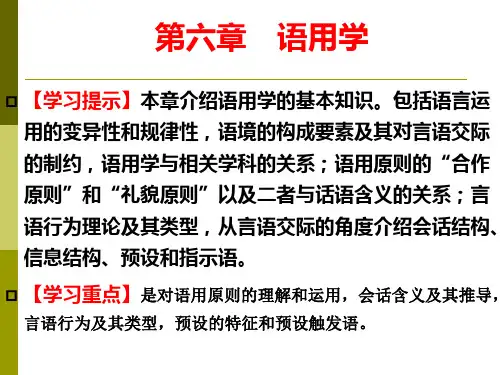

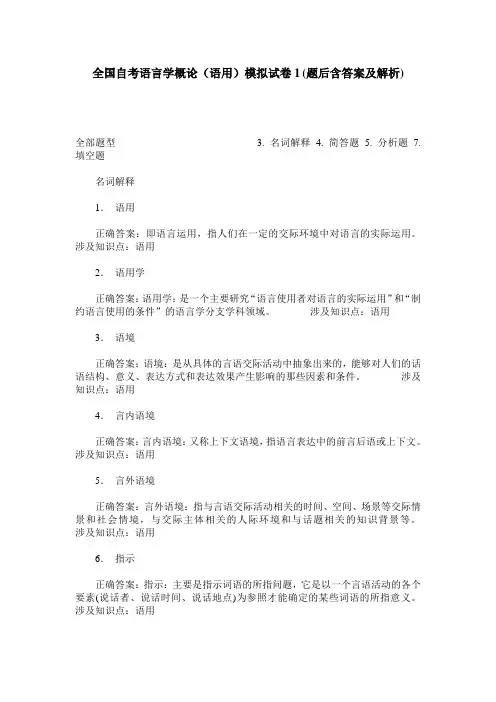
全国自考语言学概论(语用)模拟试卷1(题后含答案及解析)全部题型 3. 名词解释 4. 简答题 5. 分析题7. 填空题名词解释1.语用正确答案:即语言运用,指人们在一定的交际环境中对语言的实际运用。
涉及知识点:语用2.语用学正确答案:语用学:是一个主要研究“语言使用者对语言的实际运用”和“制约语言使用的条件”的语言学分支学科领域。
涉及知识点:语用3.语境正确答案:语境:是从具体的言语交际活动中抽象出来的,能够对人们的话语结构、意义、表达方式和表达效果产生影响的那些因素和条件。
涉及知识点:语用4.言内语境正确答案:言内语境:又称上下文语境,指语言表达中的前言后语或上下文。
涉及知识点:语用5.言外语境正确答案:言外语境:指与言语交际活动相关的时间、空间、场景等交际情景和社会情境,与交际主体相关的人际环境和与话题相关的知识背景等。
涉及知识点:语用6.指示正确答案:指示:主要是指示词语的所指问题,它是以一个言语活动的各个要素(说话者、说话时间、说话地点)为参照才能确定的某些词语的所指意义。
涉及知识点:语用7.指称正确答案:主要是一般名词的所指问题,它是指只有当一个词语进入话语作为具体谈论的对象,即与语境中特定对象发生关联时,才会有的具体的所指意义。
涉及知识点:语用8.会话准则正确答案:人们在会话中总是要表达一定的意义和达到一定的交际目的,也就必然会涉及言语交际和语言运用的一些基本规则,对这些规则的遵守或有意违反,都会对言语交际的结果、语言运用的效果产生显著影响,这些规则就是“会话准则”。
涉及知识点:语用9.合作原则正确答案:是指在言语交际中,为确保交谈双方相互配合而遵守的语用规则。
涉及知识点:语用10.礼貌原则正确答案:指出于相互尊重的需要,交谈双方在言语交际中应该遵守的语用规则。
涉及知识点:语用11.蕴含义正确答案:通常情况下是指说出的话中包含着其中某个词语的上位义或整体义。
涉及知识点:语用12.衍推义正确答案:是句子固有和稳定不变的含义,从逻辑的角度讲是指充分不必要关系:如果A为真,B一定为真;如果B为假,A也一定为假;但如果B为真,A不一定为真。
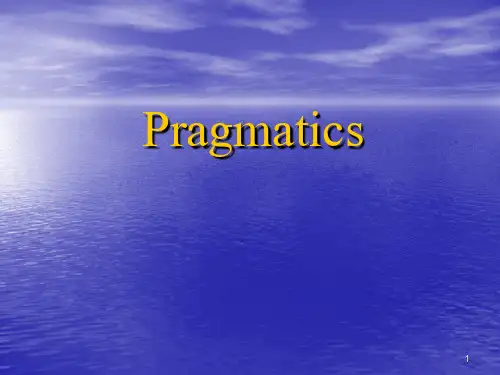

专业英语八级英语语言学知识(语用学)模拟试卷1(题后含答案及解析)题型有: 3. GENERAL KNOWLEDGEPART III GENERAL KNOWLEDGE (10 MIN)Directions: There are ten multiple-choice questions in this section. Choose the best answer to each question.1.Which of the following statement concerning context is NOT correct?A.It was first noted by the British linguist John Firth.B.It is generally considered as constituted by the knowledge shared by the speaker and the hearer.C.It determines the speaker’s use of language and also the hearer’s interpretation of what is said to him.D.It is essential to the syntactic study of language.正确答案:D解析:语境这个概念由英国语言学家John Firth最先提出,一般认为它是由言者和听者的共享知识构成,它决定着言者对语言的运用和听者对他所听到话语的理解,它对语言的语用研究(而非句法研究)来说是必不可少的。
知识模块:语用学2.Which of the following is NOT correct?A.The meaning of a sentence is abstract and decontextualized.B.The meaning of an utterance is concrete and context-dependent.C.The meaning of a sentence is based on utterance meaning.D.Utterance meaning is the realization of the abstract meaning of a sentence in a real situation of communication or simply in a context.正确答案:C解析:句子的意思是抽象的、非语境化的,而话语的意义却是具体的、依赖于语境的。
言语交际--任务一判断1、简单的说语用学就是研究语言的意义的。
(2分)AB、正确标记未做2、现代汉语修辞学的诞生,可以1932年陈望道《修辞学》的出版为标志。
(2分)AB、正确标记未做3、美国著名语言学家诺姆•乔姆斯基是欧美“结构主义语言学派”的代表。
(2分)AB、正确标记未做4、历史比较语言学着眼的是语言的现实,而不再是语言的历史。
(2分)AB、正确标记未做5、排球比赛中,裁判员想要暂停比赛,会用两手做一个T形手势,这是一个编码的过程。
(2分)A、错误B6、传播学所谓的社会传播,不包括只在两个人之间进行的言语活动。
(2分)AB、正确标记未做7、索绪尔认为“语言”存在于听话人脑子里的音响形象与概念的联结。
(2分)A、错误B8、言语交际能力是人与生俱来的东西。
(2分)AB、正确标记未做9、喜欢用图表、公式来描写语音和语法结构的欧美语言学家被统称为“结构主义语言学派”。
(2分)A、错误B10、美国著名语言学家索绪尔是现代语言学的奠基人。
(2分)AB、正确标记未做11、言语交际的基本功能是人际功能。
(2分)AB、正确标记未做12、传播学所谓的内向传播,指的是纯属个人的言语行为。
(2分)A、错误B13、“语用学”这一概念,是由美国哲学家莫里斯最早提出的。
(2分)A、错误B14、排球比赛中,,运动员们看到裁判的T形手势,就明白要暂停比赛了,这是解码的过程。
(2分)A、错误B15、亚理斯多德是西方历史上最伟大的修辞学家,著有《修辞学》一书,它是一部关于言语交际学的著作。
(2分)AB、正确标记未做16、现代信息论把听话人由“音响形象”转化为“概念”称为“解码”过程。
(2分)A、错误B17、人类言语交际的产生是为了更好的传递信息,而传递信息的最初动机又是为了加强合作。
(2分)A、错误B18、语言从本质上说是一种“符号”,一种语言也就是一个符号系统。
(2分)A、错误B19、现代信息论把说话人由“概念”转化为“音响形象”的过程称为“解码”。
Chapter 5 SemanticsI.Decide whether each of the following statements is True or False:1.Dialectal (方言的)synonyms (同义关系)can often be found in different regional dialects suchas British English and American English but cannot be found within the variety itself, for example, within British English or American English. F2.Sense is concerned with the relationship between the linguistic element and the non-linguistic worldof experience, while the reference deals with the inherent meaning of the linguistic form.F3.Linguistic forms having the same sense may have different references in different situations.T4.In semantics, meaning of language is considered as the intrinsic and inherent relation to the physicalworld of experience. F5.Contextualism is based on the presumption that one can derive meaning from or reduce meaning toobservable contexts. T6.Behaviourists attempted to define the meaning of a language form as the situation in which the speakerutters it and the response it calls forth in the hearer. T7.The meaning of a sentence is the sum total of the meanings of all its components. F8.Most languages have sets of lexical items similar in meaning but ranked differently according to theirdegree of formality. T9.“It is iscd:n”-place predication because it contains no argument. T10.In grammatical analysis, the sentence is taken to be the basic unit, but in semantic analysis of asentence, the basic unit is predication, which is the abstraction of the meaning of a sentence. T11.Fill in each of the following blanks with one word which begins with the letter given:11.Semantics can be defined as the study of meaning.12.The conceptualist view holds that there is no direct link between a linguistic form and what it refersto.13.Reference means what a linguistic form refers to in the real, physical world; it deals with therelationship between the linguistic element and the non-linguistic world of experience.14.Words that are close in meaning are called synonyms.15.When two words are identical in sound, but different in spelling and meaning, they are called homophones (同音/形异义词).16.Relational opposites are pairs of words that exhibit the reversal of a relationship between the twoitems.ponential (指数)analysis is based upon the belief that the meaning of a word can bedivided into meaning components.18.Whether a sentence is semantically meaningful is governed by rules called selectional restrictions,which are constraints on what lexical items can go with what others.19.An argument is a logical participant in a predication, largely identical with the nominalelement(s) in a sentence.20.According to the naming theory of meaning, the words in a lan- guage are taken to be labels of theobjects they stand for.III.There are four choices following each statement. Mark the choice that can best completethe statement:21.The naming theory is advanced by A.A.PlatoB.BloomfieldC. Geoffrey LeechD. Firth22.“We shall know a word by the company it keeps.,, This statement represents __B.A.the conceptualist view (概念)B.contexutalismC.the naming theoryD.behaviourism23.Which of the following is not true? DA.Sense is concerned with the inherent meaning of the linguistic form.B.Sense is the collection of all the features of the linguistic form.C.Sense is abstract and decontextualized (去文本化).D.Sense is the aspect of meaning dictionary compilers are not interested in.24.“Can I borrow your bike?”D“You have a bike.”A.is synonymous withB.is inconsistent withC.entailsD.presupposes25. B is a way in which the meaning of a word can be dissected into meaningcomponents, called semantic features.A.Predication analysisponential analysisC.Phonemic analysisD.Grammatical analysis26.“Alive” and “dead” are C.A.gradable antonymsB.relational opposites (关系对立)plementary antonymsD.None of the above27. A deals with the relationship between the linguistic element and the non-linguisticworld of experience.A.ReferenceB.ConceptC.SemanticsD.Sense28. C refers to the phenomenon that words having different meanings have the same form.A.PolysemyB.SynonymyC.HomonymyD.Hyponymy29.Words that are close in meaning are called D.A.homonymsB.polysemyC.hyponymsD.synonyms30.The grammaticality of a sentence is governed by A.A.grammatical rulesB.selectional restrictionsC.semantic rulesD.semantic featuresW. Define the following terms:31.Semantics32.sense33.reference34.synonymy35.polysemy36.homonymy37.homophones38.Homographsplete homonyms40.hyponymy41.antonymy42 componential analysis43.grammatical meaning44.predication45.Argument46.predicate47.two-place predicationV. Answer the following questions:48.Why do we say that a meaning of a sentence is not the sum total of the meanings of all itscomponents?49.What is componential analysis? Illustrate it with examples.50.How do you distinguish between entailment and presupposition in terms of truth values?51.How do you account for such sense relations between sentences as synonymous relation,inconsistent relation in terms of truth values?52.According to the way synonyms differ, how many groups can we classify synonyms into? Illustratethem with examples.53.What are the major views concerning the study of meaning? How they differ?Chapter 6 PragmaticsI. Decide whether each of the following statements is True or False:1.Both semantics and pragmatics study how speakers of a language use sentences to effect successfulcommunication2.Pragmatics treats the meaning of language as something intrinsic and inherent.3.It would be impossible to give an adequate description of meaning if the context of languageuse was left unconsidered.4.What essentially distinguishes semantics and pragmatics is whether in the study of meaning thecontext of use is considered.5.The major difference between a sentence and an utterance is that a sentence is not uttered while anutterance is.6.The meaning of a sentence is abstract, but context-dependent.7.The meaning of an utterance is decontexualized, therefore stable.8.Utterances always take the form of complete sentences9.Speech act theory was originated with the British philosopher John Searle.10.Speech act theory started in the late 50’s of the 20th century.11.Austin made the distinction between a constative and a performative.12.Perlocution ary act is the act of expressing the speaker’s intention.II.Fill in each blank below with one word which begins with the letter given:13.P is the study of how speakers of a language use sentences to effect successfulcommunication.14.What essentially distinguishes s and pragmatics is whether in the study of meaningthe context of use is considered.15.The notion of c is essential to the pragmatic study of language.16.If we think of a sentence as what people actually utter in the course of communication, it becomes anu.17.The meaning of a sentence is a, and decontexualized.18. C were statements that either state or describe, and were thus verifiable.19.P were sentences that did not state a fact or describe a state, and were not verifiable.20. A l act is the act of uttering words, phrases, clauses. It is the act of conveying literalmeaning by means of syntax, lexicon and phonology.21.An i act is the act of expressing the speaker’s intention; it is the act performed insaying something.22. A c is commit the speaker himself to some future course of action.23.An e is to express feelings or attitude towards an existing state.24.There are four maxims under the cooperative principle: the maxim of q, the maxim of quality, themaxim of relation and the maxim of manner.III.There are four choices following each statement. Mark the choice that can best complete the statement:25.does not study meaning in isolation, but in context.A.PragmaticsB.SemanticsC.Sense relationD.Concept26.The meaning of language was considered as something in traditional semantics.A.contextualB.behaviouristicC.intrinsicD.logical27.What essentially distinguishes semantics and pragmatics is whether in the study of meaningis considered.A.referenceB.speech actC.practical usageD.context28. A sentence is a concept, and the meaning of a sentence is often studied in isolation.A.pragmaticB.grammaticalC.mentalD.conceptual29.If we think of a sentence as what people actually utter in the course of communication, it becomesa(n).A.constativeB.directiveC.utteranceD.expressive30.Which of the following is true?A.Utterances usually do not take the form of sentences.B.Some utterances cannot be restored to complete sentences.C.No utterances can take the form of sentences.D.All utterances can be restored to complete sentences.31.Speech act theory did not come into being until.A.in the late 50’s of the 20the centuryB.in the early 1950’sC.in the late 1960’sD.in the early 21st century32.is the act performed by or resulting from saying something; it is the consequence of, or the changebrought about by the utterance.A. A locutionary actB.An illocutionary actC. A perlocutionary actD. A performative act33.According to Searle, the illocutionary point of the representative is.A.to get the hearer to do somethingB.to commit the speaker to something’s being the caseC.to commit the speaker to some future course of actionD.to express the feelings or attitude towards an existing state of affairs34.All the acts that belong to the same category share the same purpose, but they differ .A.in their illocutionary acts.B.in their intentions expressedC.in their strength or forceD.in their effect brought about35.is advanced by Paul GriceA.Cooperative PrincipleB.Politeness PrincipleC.The General Principle of Universal GrammarD.Adjacency Principle36.When any of the maxims under the cooperative principle is flouted,might arise.A.impolitenessB.contradictionsC.mutual understandingD.conversational implicaturesW・ Define the terms below:37.pragmatics38.context39.utterance meaning40.sentence meaning41.constative42.performative43.locutionary act44.illocutionary act45.perlocutionary act 46. Cooperative PrincipleV. Answer the following questions as comprehensively as possible. Give examples fOr illustration if necessary:47.How are semantics and pragmatics different from each other?48.How does a sentence differ from an utterance?49.How does a sentence meaning differ from an utterance meaning?50.Discuss in detail the locutionary act, illocutionary act and perlocutionary act.51.Searle classified illocutionary act into five categories. Discuss each of them in detail withexamples.52.What are the four maxims under the cooperative principle?53.How does the flouting of the maxims give rise to conversational implicatures?。